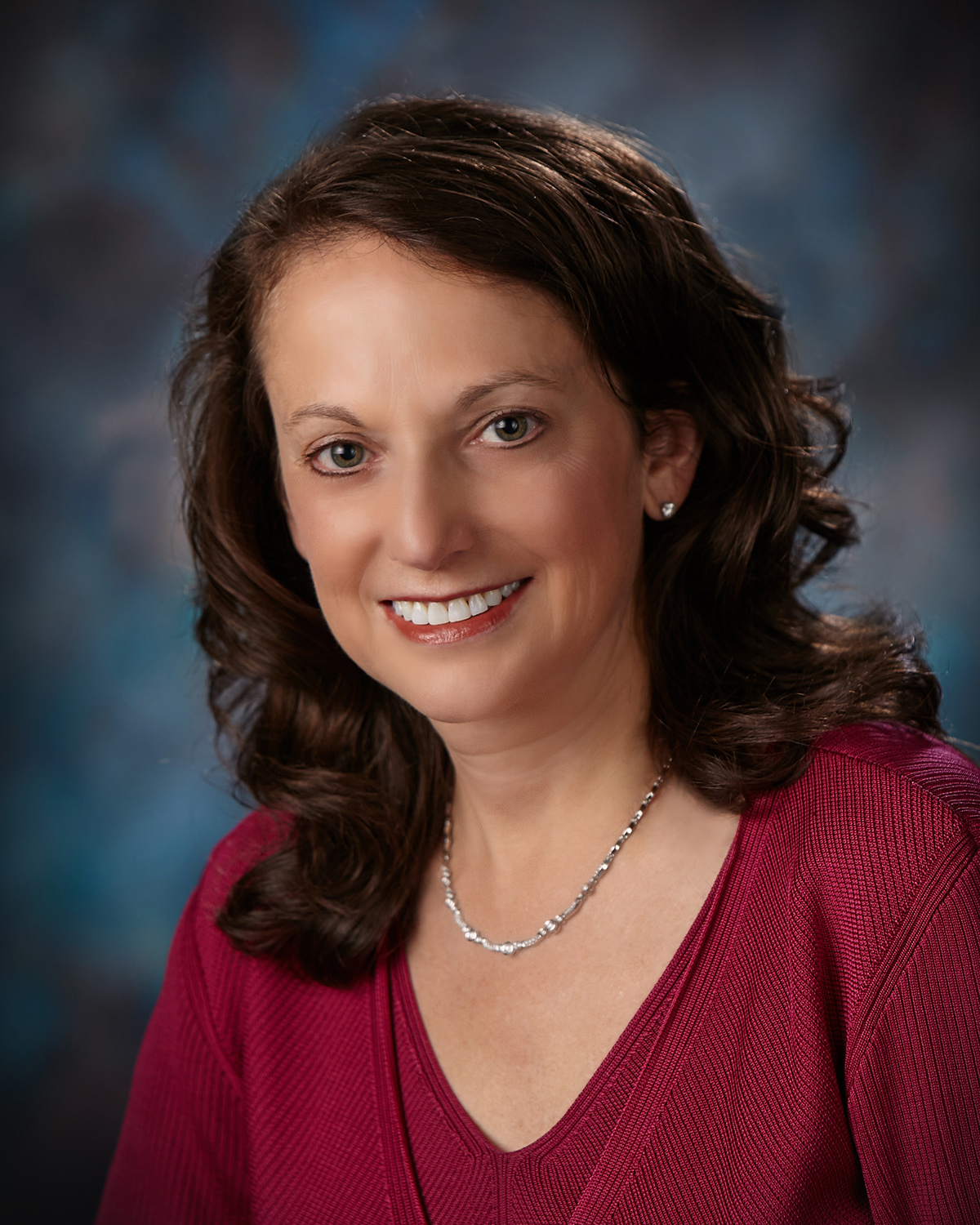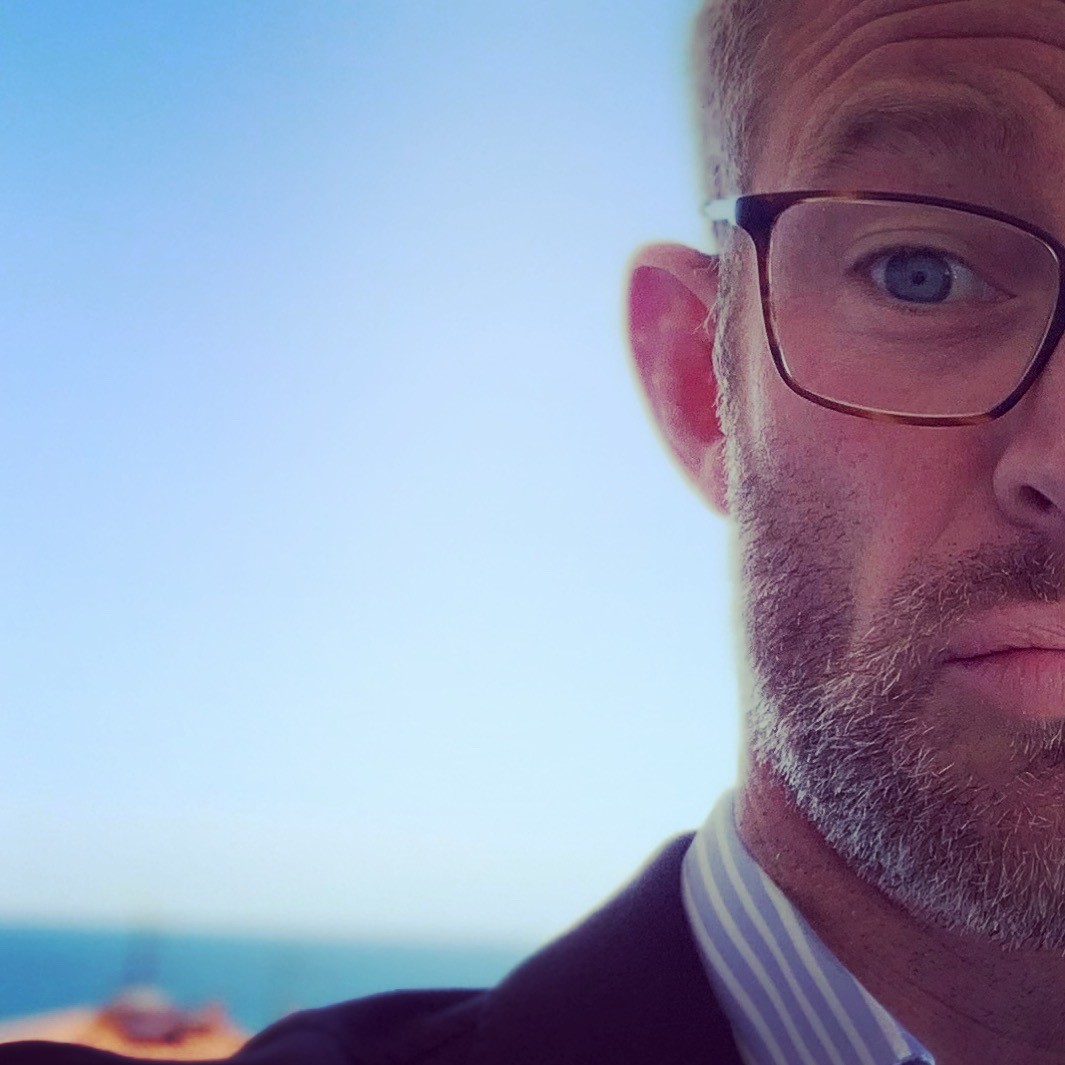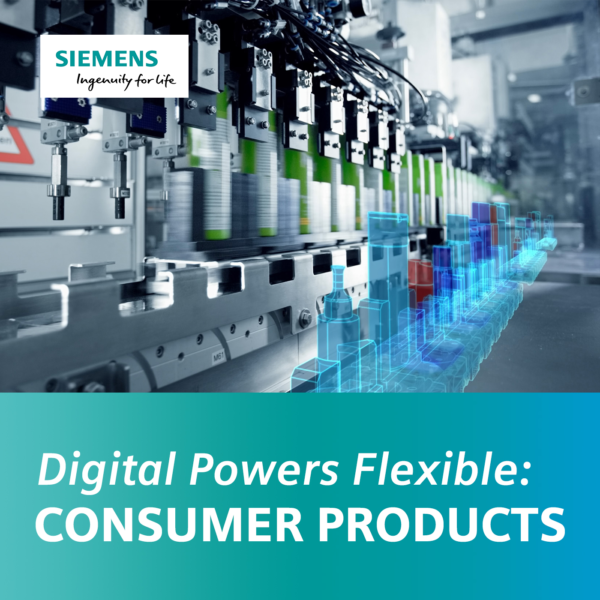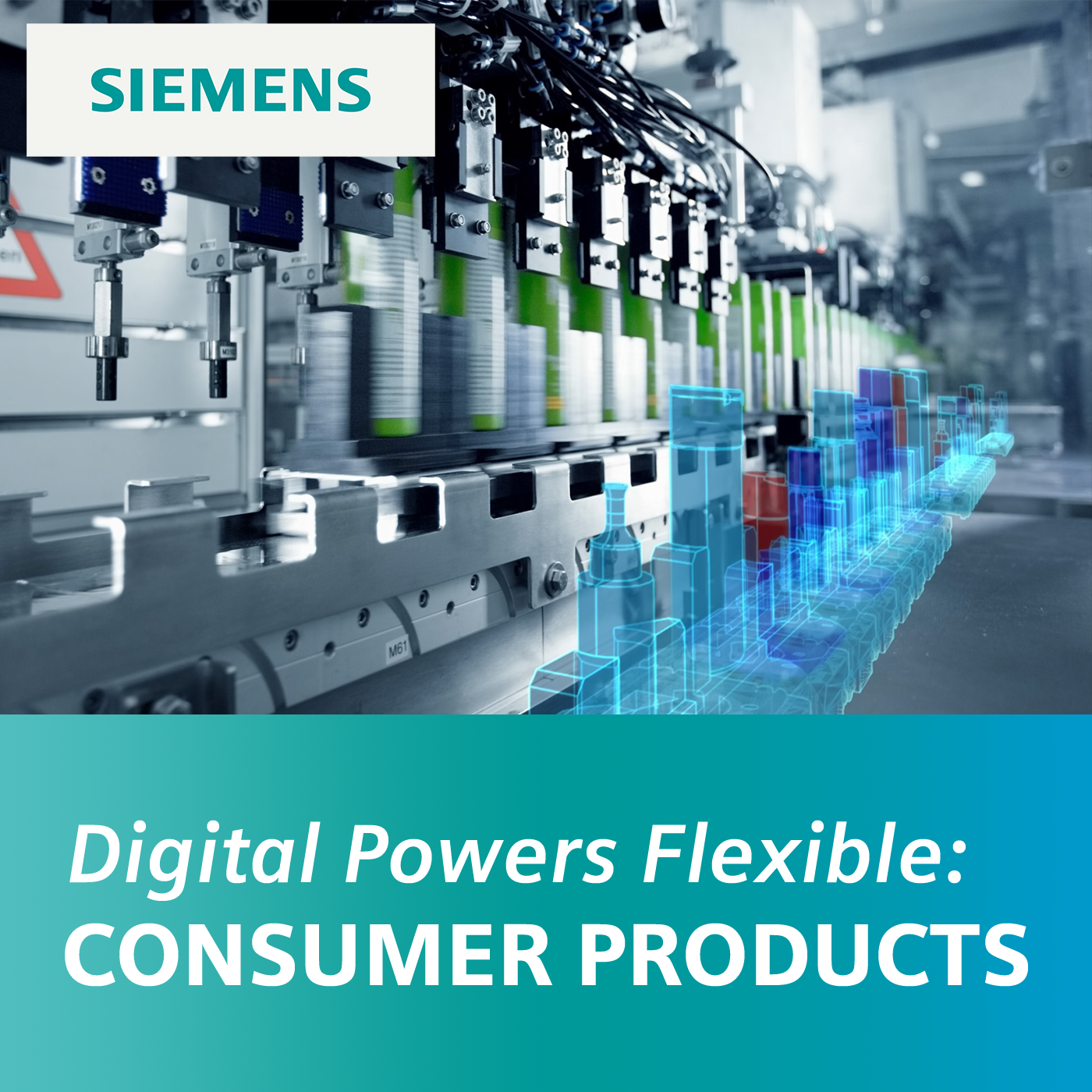Consumer Products Podcast – Planning for Flexibility in a Consumer-Driven Market (Ep. 1)

Siemens Digital Industries Software is starting a new podcast series focused on consumer products and the digital transformation. This first episode examines the major challenges of consumer product manufacturers such as the growing demand for product personalization, the need for flexible manufacturing processes and improved supply chain resiliency.
Listen to our two experts—Suzanne Kopcha, Vice President Consumer Products & Retail Industry and Alastair Orchard, Head of Digital Enterprise Thought Leadership discuss how digital transformation is changing consumer product manufacturing here:
Steve Hartman: Consumer expectations consistently change based on local needs, cost, trends, the safety of what’s consumed, and having what we want, when we want it. Look at the conversation around sustainability and you’ll see that consumers have pushed regulators to ban plastics, that they’re spending their money on companies that make a positive impact on the environment or society. Therefore, the consumer is a driver of the innovation in personal products, that is changing the dynamics of the industry. This drives the need for flexibility. To accomplish this level of demand and customization, companies must have the ability to personalize on a mass scale, while being adaptable to an ever-changing market. This is truer today than ever before.
Welcome to the Digital Powers Flexible podcast. We’re going to explore the consumer products industry, some of the challenges the industry faces and how digitalization is changing how companies in this space operate and succeed.
Siemens has provided solutions for this industry for years and here, with me, to discuss this topic are Suzanne Kopcha – who has been a part of Siemens for over five years and is responsible for industry strategy for consumer products; before joining Siemens, she spent 25 years at Procter & Gamble – and Alastair Orchard, who has been at Siemens now for almost 20 years. A chemical engineer by trade, Alastair has been driving digitalization at Siemens since the beginning. He was one of the first people who defined the company’s so-called ‘Digital Enterprise Portfolio’ – a holistic portfolio of software and automation solutions for customers in the process and discrete industry. And I’m Steve Hartman with the branding and communications team. We’re here to discuss consumer products and meeting the needs of the consumer in an ever-changing landscape. Welcome, Suzanne and Alastair, and thank you for joining us!
Consumer Products is a broad term. Suzanne, can you explain what you mean when we discuss consumer products?
Suzanne Kopcha: Thanks, Steve! Consumer Products is a very broad term. We have a really broad scope of products with very different business models and really different products. The products can range from the wine and chocolate that makes us happy, the electric toothbrush razor, cosmetics, perfume or jewelry that makes us feel beautiful, and the athletic shoes, wearables, and running pants that help us stay fit. We also work with the appliances that we cook with or we wash our clothes with, and then, the retail stores that sell us all of these products online or in a brick & mortar store. It’s an incredible set of customers that we work with. It’s an exciting market, and there’s a lot happening.
When we think about the market, there’s a few characteristics that really define some of the challenges that our customers are dealing with. The first and foremost is that the consumer is driving everything. There are examples in this industry, in the past 10 years, where the paramount pinnacle form of success was becoming a billion-dollar brand. Now, consumers can either erode the value of a brand or build the value of a brand in, what I call, a nanosecond. Rider – the scooters that we see all over our cities – was the fastest brand to become a billion-dollar brand – we call them unicorns – and that was driven by the combination of empowered consumers that saw the need for this new product and the power of their voice on social media.
Steve Hartman: This industry is known for extremes, right? I mean, there have been world issues like the pandemic that shut companies down and other times companies can’t make enough products. Some of them are electromechanical, some of them are formulated – and they have all different kinds of manufacturing processes…
Suzanne Kopcha: And one of the stresses today is that eCommerce and consumer-driven manufacturing is changing everything about what they do. When we think about retailers, we think about the power of the consumer in social media but we also think about the power of the retailer in today’s world. In this industry, data has always been a currency, and our big companies used to own it. But now, data is the new currency that retailers own.
Some of our companies are leaders in digital transformation and using digital to help solve these problems, but overall, this industry is really immature when it comes to digital. Many may not survive unless they accelerate their transformations. They’ll just not have the flexibility or the resiliency that they need without mature digital capabilities.
Steve Hartman: Thank you, Suzanne. Since we’ve introduced the idea of digital and digitalization, I’d like to share the story how digitalization first became part of the conversation.
The story holds legendary status at Siemens. In the mid-2000s, a man named Anton S. Huber was the head of our industry division. He continued the success of the automation business within Siemens while also being known as a visionary. One day, he meets with the management board and says, “For a long time, companies determined what the customers wanted. Soon, however, customers would be the ones to define what they wanted. Siemens, and most other businesses, would have to build what individual consumers were asking for if they wanted to continue to be successful.
At the time, hardware was the basis for innovation – “this would change,” Anton said, “It was going to be software.”
Alistair, how did Anton manage to make that transition?
Alastair Orchard: He did what he’s always done since he was a kid – he went walking in the mountains, in the Alps. And the story goes that he found himself sitting in front of his favorite mountain – the Matterhorn and he looked at it, he thought, “this mountain has always been there, it’s always going to be there. It’s immovable. What an amazing metaphor for the company that I’ve helped build! How am I supposed to move this company if it’s like a mountain?” At the base of the Matterhorn is this beautiful lake – and it was a very still day and so the surface of the water was very reflective and in the surface, he could see this perfect reflection of the mountain.
And he had a kind of inspiration. He went back to Munich, burst into the boardroom and said, “I’ve got it! We’re not going to change our company directly – not at first anyway; it’s too big, it’s immovable. We’re going to create a reflection of that company, a digital twin of that company in the virtual world. If we could represent all of our products in a computer, and use the power of computers to react instantly to the requirements of customers, we can use algorithms to design products and support our amazing engineers so that we could come to answers that our customers are asking far faster than ever before. We could take that product that we’ve designed, and that we’ve simulated, and that we’re pretty sure is going to work and we could put it into the virtual factory and see if it’s manufacturable. And if it isn’t, we can tweak the design, we can identify bottlenecks in the factory and inefficiencies, and we can solve them in the virtual world.”
And they said, “Well, that’s awesome, but at some point, you’ve got to make it in the physical world.” And so Anton said, “once we’ve simulated something, then we can make it for real and we can do it efficiently and quickly and flexibly, and we can make sure that our products are built right the first time.”
Steve Hartman: He continued to tell them how the real products would be outfitted with sensors that collects data and allows engineers to compare how products performed in the real world versus the virtual world. This continuous loop meant learning how to improve both the products while they were with the customers and the next generation of products.
They liked his vision and asked what he needed.
Alastair Orchard: And so he said, “Well, I need software – and I need lots of it!” This is when they gave the approval to make the first major software acquisition. And over the last 13 years, we’ve spent actually $13 billion on software, and along the way, we’ve used that to do what Anton promised in our factories. We have 300 factories and we’ve revolutionized the way those factories interact with customers, the way that they operate and manufacture; maybe the most famous one is actually Amburg. I know we talk a lot about Amburg, but if I use an example for what I’ve just talked about, we were always very, very proud of the quality of the products that our factories made. In terms of efficiency we are 13 times more efficient now than we were at the beginning of our journey, and I think this is a true indication of what digitalization can do. Along the way, the software that we’ve acquired and integrated and developed and improved and brought to bear on our own factories now makes up a platform that we call Xcelerator that we offered to the market, to other customers, to other manufacturers to allow them to go through that same transformation that we’ve done.
Steve Hartman: Suzanne, you had said that there’s a crisis at hand in the consumer products. Let’s bring this back to consumer products and how this fits in with the digital transformation Anton was envisioning.
Suzanne Kopcha: So, Steve, I think that there’s a lot of consumer products companies that are making the same realization or reflecting the same way that Anton did when he was in the mountains. Some of them have realized the value of digital technologies and what that digital twin or the virtual world can do for them. Some of them are still, frankly, looking for an easy button and haven’t figured out what it is that they need to do going forward. But they’re facing some pretty big challenges right now. The industry was designed for that retail store. A lot of the processes were designed for long lead times. Frankly, initiative cycles were determined by when shelf resets were going to happen – when you think about the consumer packaged goods, it’s part of our industry. When a big retailer was going to change their shelf set determined when products were going to go into market because you wanted to fight for retail shelf space, so that your product would succeed.
In today’s world, we talk about consumer-driven. The difference between a retail shelf set driving the timeline of innovation, and a consumer wanting to order something personalized for themselves and delivered within 48 hours is turning the industry upside down. A lot of the manufacturing capacity has been designed to make billions of the same product, not millions or billions of different products, all with a single execution specific for a single consumer, with that consumer wanting traceability to know exactly where their product came from, to know that the claims that the company is making are true. They don’t believe a claim anymore. They want proof of it.
Steve Hartman: And what about sustainability?
Suzanne Kopcha: Sustainability used to be something that people put on their website and it was something that the PR organizations talked about, and people had to have a plan, but it wasn’t something that drove their innovation cycle; it wasn’t something that drove whether consumers would buy their products or not. Today it does. Millennials are spending their dollars with companies that are adding value to the environment, not hurting it. And they want proof that the products they buy are good for the environment or, at minimum, not bad for the environment, that they have the products in them that people claim them to be – whether they’re non-GMO, or they’re gluten-free, or they’re organic, or they’re paleo – a lot of those things we used to take for granted; today, the consumer really wants proof that they are what they are, and they’re getting the products that they ask for. And they want the traceability, to be able to have access to that information.
Another thing that’s really happening that makes this very relevant to consumer products is the acceleration of eCommerce. Companies now have to look at what is the flexibility that they need in their planning processes, in their manufacturing processes, in their warehousing and distribution processes, so that if a consumer wants to buy their product, that product can be one day away from being in the hands of the consumer. But most consumers nowadays don’t have patience more than that, and that has significant ramifications on how companies can manufacture and where and how they do their warehousing and distribution. They’re still doing things very manually and they haven’t embraced the digital technologies that will give them the flexibility that they need to be able to do that and make the margins and money that they want to. Right now, we’re seeing many companies completely disrupted by the current situation, and disruption supply chain resiliency is one of the hottest topics within our customer conversations and even on the web. The industry has really looked the last 10 or 20 years at the cost of sourcing and sourced products from very distant places – a lot of times in Asia – for key products, and they’ve made their inventories extremely lean, which puts a huge risk on resiliency, and we’re seeing a lot of that manifest itself right now. I think that will change in the future and it’ll be really interesting to see how the digital technologies that we work with every day can help people prepare for a much more responsive and resilient world post this current crisis.
Steve Hartman: Thank you, Suzanne and Alastair for giving us the first glimpse into the consumer products industry’s struggles to adapt to an ever-changing marketplace as well as a hint on how digitalization can help businesses within this sector grow.
Consumer products cover a nearly unlimited range of offerings—the wines and chocolates that make us happy, the electric toothbrush, razor, cosmetics, perfume or jewelry that make us feel beautiful, and the athletic shoes, wearables and running pants that help us stay fit. It also includes the appliances that we cook with or we wash our clothes with, and then, the retail stores that sell us all of these products online or in a brick & mortar store.
What unites all these disparate markets is the consumer that drives everything. Consumers can build the value of a brand almost instantaneously or erode the value of a brand just as quickly. Today, billion-dollar brands are emerging in a matter of years, by the combination of empowered consumers that see the need for a new product and the power of their voice on social media.
Kopcha and Orchard will examine how digital transformation plays a crucial role in enabling consumer product and retail companies to thrive in this new environment. They discuss the imperative to accelerate the digital maturity of the industry to deliver the flexibility and resiliency needed to keep pace with consumer demands. Manufacturing companies need to switch from making billions of the same product to millions or billions of different products, all with a single execution specific to the individual consumer.
Companies need flexibility in their planning processes, in their manufacturing processes, in their warehousing and distribution processes to meet the ever-changing needs of consumers. Some companies have realized the value of digital technologies and what the digital twin or the virtual world can do for them.
To continue the conversation, the next episode in the series is now available.

Suzanne Kopcha – Speaker
Suzanne has been a part of Siemens for over five years and is responsible for industry strategy for consumer products; before joining Siemens, she spent 25 years at Procter & Gamble.

Alastair Orchard – Speaker
Alastair runs the Digital Enterprise Thought Leadership team for Siemens Digital Industries, working with multinationals to become more flexible, cost effective, transparent, collaborative organizations, and to bring their world-class products to market faster than their competitors.

Steve Hartman – Host
Steve has been at Siemens for over two years and is responsible for writing various content as well as producing videos and podcasts.

Digital Powers Flexible: Consumer Products
Siemens Digital Industries Software is starting a new podcast series focused on consumer products and the digital transformation. This first episode examines the major challenges of consumer product manufacturers such as the growing demand for product personalization, the need for flexible manufacturing processes and improved supply chain resiliency.
